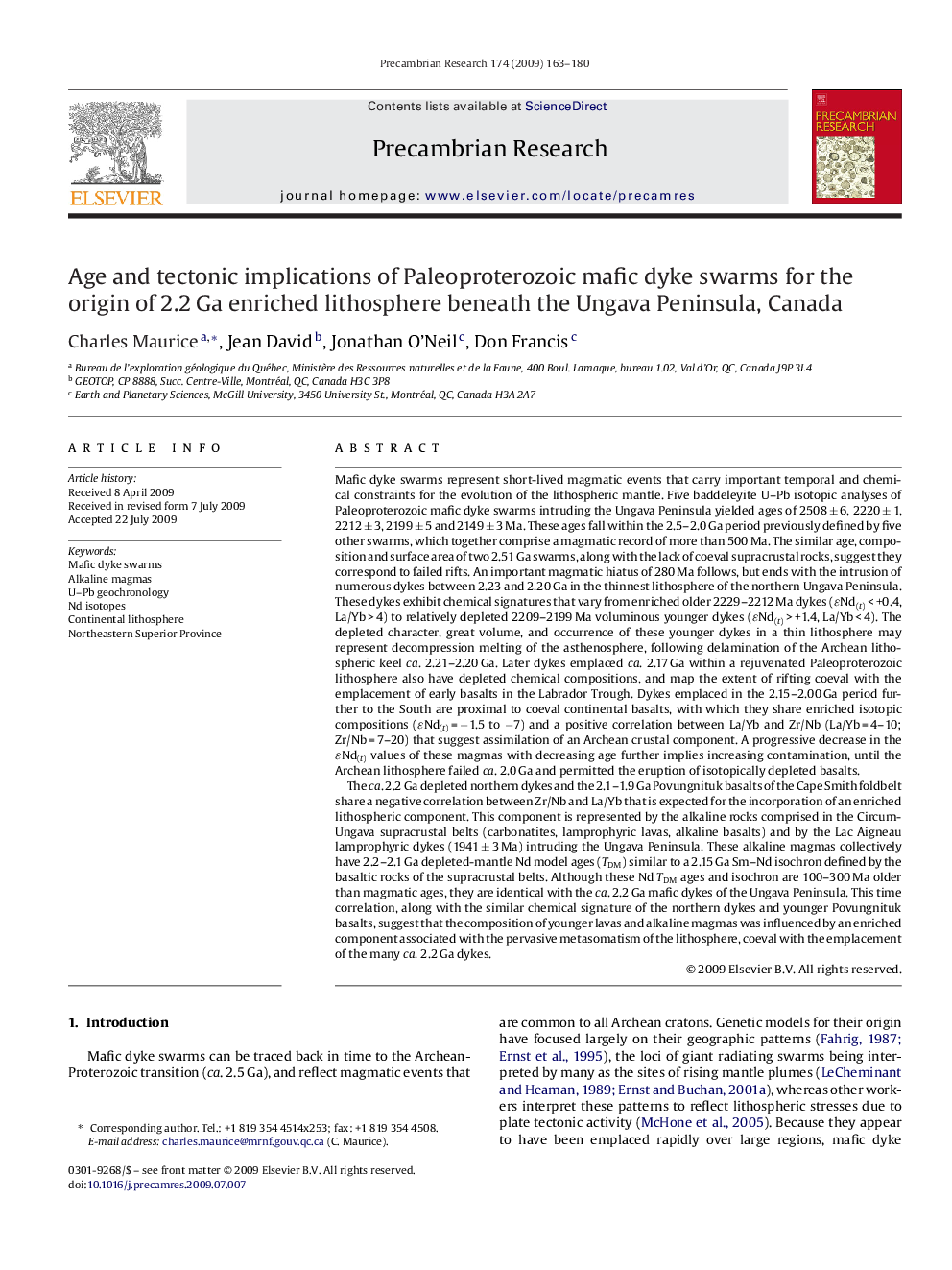| کد مقاله | کد نشریه | سال انتشار | مقاله انگلیسی | نسخه تمام متن |
|---|---|---|---|---|
| 4723955 | 1639686 | 2009 | 18 صفحه PDF | دانلود رایگان |

Mafic dyke swarms represent short-lived magmatic events that carry important temporal and chemical constraints for the evolution of the lithospheric mantle. Five baddeleyite U–Pb isotopic analyses of Paleoproterozoic mafic dyke swarms intruding the Ungava Peninsula yielded ages of 2508 ± 6, 2220 ± 1, 2212 ± 3, 2199 ± 5 and 2149 ± 3 Ma. These ages fall within the 2.5–2.0 Ga period previously defined by five other swarms, which together comprise a magmatic record of more than 500 Ma. The similar age, composition and surface area of two 2.51 Ga swarms, along with the lack of coeval supracrustal rocks, suggest they correspond to failed rifts. An important magmatic hiatus of 280 Ma follows, but ends with the intrusion of numerous dykes between 2.23 and 2.20 Ga in the thinnest lithosphere of the northern Ungava Peninsula. These dykes exhibit chemical signatures that vary from enriched older 2229–2212 Ma dykes (ɛNd(t) < +0.4, La/Yb > 4) to relatively depleted 2209–2199 Ma voluminous younger dykes (ɛNd(t) > +1.4, La/Yb < 4). The depleted character, great volume, and occurrence of these younger dykes in a thin lithosphere may represent decompression melting of the asthenosphere, following delamination of the Archean lithospheric keel ca. 2.21–2.20 Ga. Later dykes emplaced ca. 2.17 Ga within a rejuvenated Paleoproterozoic lithosphere also have depleted chemical compositions, and map the extent of rifting coeval with the emplacement of early basalts in the Labrador Trough. Dykes emplaced in the 2.15–2.00 Ga period further to the South are proximal to coeval continental basalts, with which they share enriched isotopic compositions (ɛNd(t) = −1.5 to −7) and a positive correlation between La/Yb and Zr/Nb (La/Yb = 4–10; Zr/Nb = 7–20) that suggest assimilation of an Archean crustal component. A progressive decrease in the ɛNd(t) values of these magmas with decreasing age further implies increasing contamination, until the Archean lithosphere failed ca. 2.0 Ga and permitted the eruption of isotopically depleted basalts.The ca. 2.2 Ga depleted northern dykes and the 2.1–1.9 Ga Povungnituk basalts of the Cape Smith foldbelt share a negative correlation between Zr/Nb and La/Yb that is expected for the incorporation of an enriched lithospheric component. This component is represented by the alkaline rocks comprised in the Circum-Ungava supracrustal belts (carbonatites, lamprophyric lavas, alkaline basalts) and by the Lac Aigneau lamprophyric dykes (1941 ± 3 Ma) intruding the Ungava Peninsula. These alkaline magmas collectively have 2.2–2.1 Ga depleted-mantle Nd model ages (TDM) similar to a 2.15 Ga Sm–Nd isochron defined by the basaltic rocks of the supracrustal belts. Although these Nd TDM ages and isochron are 100–300 Ma older than magmatic ages, they are identical with the ca. 2.2 Ga mafic dykes of the Ungava Peninsula. This time correlation, along with the similar chemical signature of the northern dykes and younger Povungnituk basalts, suggest that the composition of younger lavas and alkaline magmas was influenced by an enriched component associated with the pervasive metasomatism of the lithosphere, coeval with the emplacement of the many ca. 2.2 Ga dykes.
Journal: Precambrian Research - Volume 174, Issues 1–2, October 2009, Pages 163–180